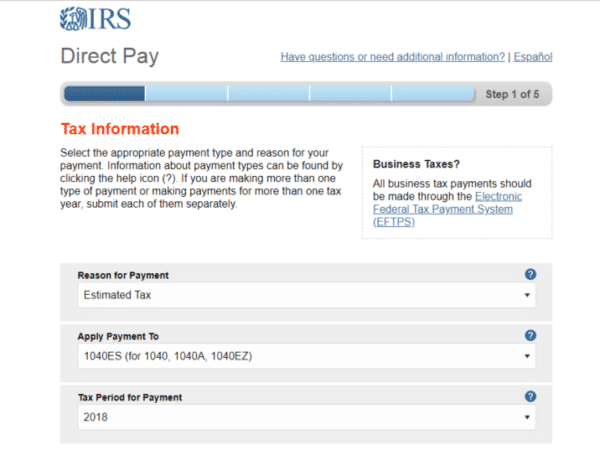Assuming you’ve given your tax preparer all of the documents needed to verify your wages, business income and expenses, crypto gains and losses, interest, dividends, etc., determining your annual tax liability is a simple process.
When you pay your Federal and state income taxes, your crypto tax liability is included within the grand total. Therefore, there really is no distinction between paying taxes on crypto and paying taxes on your other sources of taxable income and capital gains. So the question of how to pay taxes on cryptocurrencies might be better phrased as how to pay Federal income taxes.
How to Pay Taxes on Cryptocurrencies – and Everything Else
Fill out Form 1040-ES and Pay Your Quarterly Estimated Taxes
This step is ground zero when it comes to preparing for and then paying your Federal income taxes. Fill out your Form 1040-ES accurately at the start of the tax year and make your quarterly estimated tax payments to the IRS on time. Then your year-end tax underpayment will be small (no penalties) or your tax refund will be equally small. No big deal if you owe Uncle Sam a relatively small amount of tax at year-end.
But, what if your estimates for your wages, net business income, and crypto capital gains and losses are far less than what you eventually earn in the coming tax year? Then your quarterly estimated tax payments will also be too small. You should expect to be hit with underpayment penalties and, of course, will need to pony up the additional Federal tax due on April 15th.
Payday for the US Treasury
After you fill out your Form 1040-ES, you’ll be provided a dollar amount for how much money to send the US Treasury on January 15th, April 15th, June 15th and September 15th (sometimes the due date varies by a day or two). You simply write a check to the United States Treasury for the amount of estimated tax due, put your social security or taxpayer ID number on the check (money orders are gladly accepted, too. Pick up a Slurpee at the same time and make tax time a real party!) and also write “2018(9) Form 1040-ES.”
Mail your check or money order along with your payment voucher to the proper IRS address included in the Form 1040-ES instruction booklet. Presto, you’ve paid your quarterly estimated taxes.
[thrive_leads id=’5219′]
What if Your Income Suddenly Rises or Falls Mid-Year?
Let’s say you’ve filled out your 2019 Form 1040-ES in mid-January 2019. You’ve made a good-faith estimate of your 2019 crypto capital gains, interest, dividends, wages, and net business income.
But say something happens in March. You suddenly have a 2,500% winner on an ICO token that nets you $40,000, or your company gains a big contract that boosts your bottom line by $100,000. Perhaps you become sick or disabled, and your income shrinks to nothing. Maybe your wife/husband dumps you for a better-looking guy/gal with more dough and takes your house just for fun.
You need to account for all of these financial changes and fill out a new 1040-ES. That way, when it’s time for your next quarterly tax payment, you’ll send in the revised (higher or lower) estimated tax payment. If your taxable income continues to fluctuate throughout the year, fill out a new 1040 ES each time and make the needed revisions.
As long as you don’t have a significant underpayment on April 15th of the following tax year, you have no worries at all. The 1040-ES is a valuable ally that can help you avoid underpayment penalties.

Settling Scores with The Man
The IRS now offers at least ten different ways for you to remit your tax payments. Many require additional processing fees, but several do not (check, IRS Direct Pay).
Here are the IRS tax payment methods currently available:
- IRS Direct Pay (free)
- Electronic Funds Withdrawal (EFW)
- Electronic Federal Tax Payment System (EFTPS)
- Check
- Wire transfer (bank fees apply)
- Money order (gotta pay for this critter along with your Slurpee)
- Credit card (fees apply)
- Debit card (fees apply)
- Cash (incredibly, a $3.99 fee applies for cash payments!)
And if you end up owing the IRS some really big money, they offer you the special Installation Agreement (for tax, interest and penalty debts of $50,000 or less). No word yet if they break your legs if you fail to agree to the terms, but I suspect most folks willingly sign on the dotted line.
An Offer He Couldn’t Refuse, but He Had No Credit Card Available
Sometimes, a particular taxpayer just doesn’t have the money needed to settle up with the IRS. At least not right away.
Take the case of Long Island mobster Michael Franzese.
A made man and caporegime in the Colombo family, Franzese was perhaps the biggest earner in the history of US organized crime. For a period of several years (ending in 1985), his federal gasoline tax fraud operation earned six to eight million dollars — per week. The revenue lost to the Feds was far greater. Franzese and his cartel stole thirty-five cents in unpaid federal gas taxes for each gallon of gas sold. At nearly half a billion gallons per month, the cost to the US Treasury was astronomical.
Postcard from the Edge
Of course, he was eventually convicted of a huge laundry list of criminal offenses including his incredible gas tax heist. Sitting in a Federal penitentiary in 1988, he received a letter from the IRS. They informed him that he owed $50 million in back taxes for his personal earnings from the huge scam. Apparently, they must have believed he still had the capacity to settle his tax debt, for at the bottom of the letter space was provided for Franzese to fill in his Visa, Mastercard, or American Express number.
As he wrote in his 2009 book, I’ll Make You an Offer You Can’t Refuse,
“Had I had access to my credit card, I would have filled in the number and sent it in.”
Thankfully, you’re not in a situation like that. However, there’s an important lesson here for all cryptocurrency traders and taxpayers in general. Here it is: The IRS has an extremely good memory when it comes to collecting money they believe they’re owed, and it doesn’t matter to them if your taxable income came from legal or illegal sources.
Final Thoughts – Two Decades
It took Michael Franzese twenty years to finally work out a payment plan for his $50 million worth of IRS back taxes. Long after he was paroled, he was forced to repay the debt as he earned a non-Mafia living like the rest of us.
File and pay your estimated taxes on time, every time. Calculate your cryptocurrency gains and losses to the penny and use the best tax preparation service or software available by April 15th. That way, you can enjoy your crypto gains, sleep well at night and never have to worry about an IRS shakedown.
Never Miss Another Opportunity! Get hand selected news & info from our Crypto Experts so you can make educated, informed decisions that directly affect your crypto profits. Subscribe to CoinCentral free newsletter now.










